When it comes to healthy, hassle-free cooking, few kitchen tools can rival a high-quality ceramic sauté pan. Whether you’re browning chicken, tossing stir-fries, or simmering a rich sauce, the right sauté pan can completely change how you cook — and how your food tastes. Ceramic-coated cookware has become a favorite among home cooks and chefs alike because it offers non-toxic, nonstick performance without the use of harmful chemicals like PTFE, PFOA, or lead.
But not all ceramic pans are created equal. Some deliver silky-smooth cooking and easy cleanup for years, while others lose their shine (and nonstick ability) in just a few months. That’s why finding the best ceramic sauté pan means understanding more than just looks or brand names — you need to consider durability, performance, and safety.
In this guide, we’ll walk you through exactly what to look for before buying a ceramic sauté pan, so you can invest in one that truly earns its place in your kitchen.
Buying Guide: What to Look for in the Best Ceramic Sauté Pan
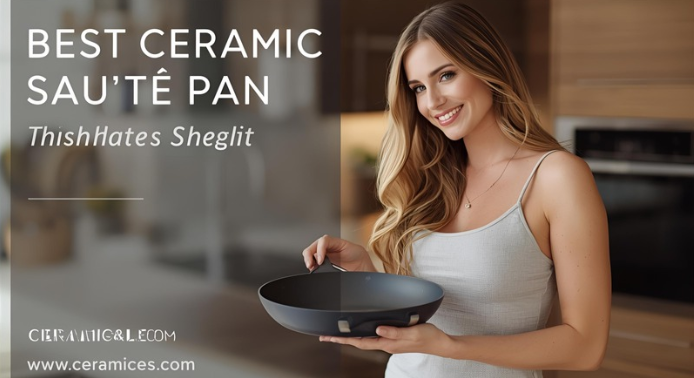
1. Material and Construction
Ceramic sauté pans are typically made from an aluminum or stainless steel base coated with a ceramic layer.
- Aluminum pans heat quickly and evenly — great for everyday cooking.
- Stainless steel pans are more durable but take longer to heat up.
Whichever you choose, make sure the pan has a solid, heavy-gauge construction to prevent warping and ensure long-lasting performance.
2. Nonstick Coating Quality
The ceramic coating is the star of the show. Look for brands that use high-quality sol-gel ceramic coatings, which are made without PFAS and other harmful chemicals. A premium coating means better food release, less oil usage, and easier cleaning.
3. Size and Depth
A good sauté pan should offer enough space to move food around without overcrowding.
- 10 to 12 inches is the sweet spot for most home kitchens.
- Choose a deeper pan (around 2.5–3 inches) if you like cooking sauces or one-pan meals.
4. Handle Design and Comfort
Since sautéing often involves moving or tossing food, the handle matters a lot. Go for ergonomic, heat-resistant handles that feel comfortable and stay cool on the stovetop. Riveted or stainless-steel handles are usually sturdier than glued ones.
5. Lid Quality
A tight-fitting lid locks in heat and moisture — essential for simmering or braising. Tempered glass lids are great because they let you monitor food without losing heat.
6. Compatibility with Cooktops
Check if the sauté pan is compatible with your stovetop — especially if you use induction. Not all ceramic-coated pans work on induction burners, so always double-check the manufacturer’s specifications.
7. Oven Safety
If you like finishing dishes in the oven, choose a pan that’s oven-safe up to at least 400°F (204°C). Always verify whether the handle and lid can handle the same temperature.
8. Ease of Cleaning
One of the biggest perks of ceramic cookware is easy cleanup. Most ceramic sauté pans can be wiped clean with mild soap and a soft sponge — but avoid metal utensils or harsh scrubbers that can scratch the coating.
9. Brand Reputation and Warranty
Stick with brands known for durable ceramic cookware — like GreenPan, Caraway, Blue Diamond, or GreenLife. A solid warranty is also a good sign that the company stands behind its product.
1. GreenPan Valencia Pro Ceramic Nonstick 11″ Sauté Pan
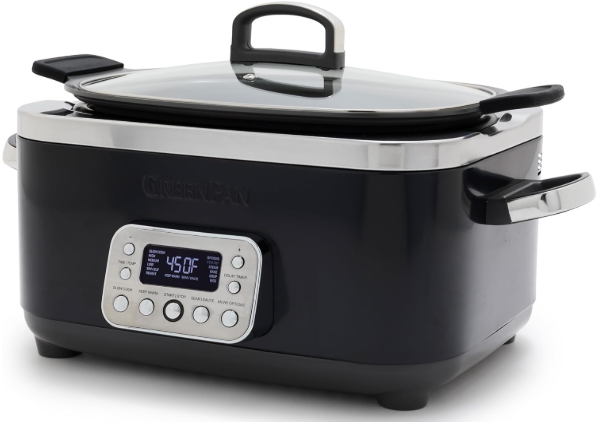
Product Description
GreenPan is a well-established name in ceramic cookware. The Valencia Pro line is one of its premium offerings, featuring Thermolon™ ceramic nonstick coating over a hard-anodized aluminum body. The 11″ sauté pan gives ample surface area, moderate depth, and is oven-safe to moderate temperatures. It aims to combine good heat conduction, nonstick performance, and durability in everyday use.
Key Features
- Thermolon™ ceramic nonstick (PFAS/PFOA-free)
- Hard-anodized aluminum body for even heating
- Induction-compatible (with magnetic base)
- Oven safe (often up to ~425–450 °F, though confirm on model)
- Riveted stainless steel handle, stay-cool design
- Tempered glass lid (on many models)
Pros
- Good nonstick performance for many everyday tasks
- Lighter and easier to maneuver than heavy cast materials
- Safe for many cooktops, including induction (on appropriate model)
- Attractive design and finish
- Backed by a known brand with warranty support
Cons
- The ceramic nonstick will degrade over time and with high-heat abuse
- Might not withstand metal utensils or abrasive scrubbing
- Lid or handle may limit oven temperature
- More expensive than budget ceramic pans
Recommendation
This is a solid all-around pick if you want a relatively premium ceramic sauté pan for regular home use. If you sauté vegetables, chicken, sauces, etc., and are careful about temperature (using medium heat, avoiding overheating), this pan will serve you well. It’s especially good if you want brand reliability and a balance between performance and safety.
2. KitchenAid Hard-Anodized Ceramic Nonstick Sauté Pan (5-qt / ~11-12″ equivalent)
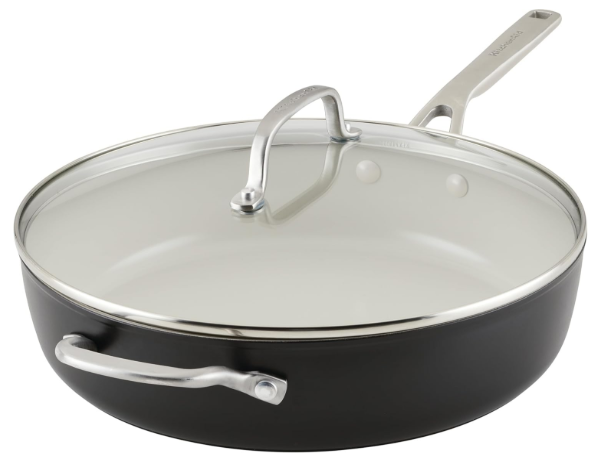
Product Description
KitchenAid’s hard-anodized ceramic nonstick sauté pan is designed to blend the durability of hard-anodized aluminum construction with a ceramic nonstick interior. It is more robust than many ultra-thin pans, and aims to deliver even heating, easy release, and oven-to-table versatility. The hard-anodized shell resists warping, and the ceramic core helps reduce sticking and makes cleanup easier.
Key Features
- Hard-anodized aluminum body for strength & heat conduction
- Ceramic nonstick interior (PTFE-free)
- Oven safe (often up to ~500 °F for the pan; check lid limits)
- Induction compatibility on certain models
- Snap-fit glass lid or tempered glass lid (depending on model)
- Long ergonomic handle, sturdy construction
Pros
- More durable than thin aluminum pans
- Better heat distribution, less hot-spot risk
- Good for one-pan meals (thanks to depth and surface area)
- Useful oven safety gives flexibility in finishing recipes
Cons
- The lid might have a lower maximum oven temp than the pan itself
- Heavier than basic pans — slightly less nimble for tossing
- Ceramic coating will wear over time, especially under high heat
- More expensive than entry-level models
Recommendation
If you like to finish dishes in the oven (e.g., sauté on stovetop, then bake or broil), this pan is a good choice. Also ideal for people who cook richer, longer-cooked recipes (braises, reductions) because of its sturdier body. If your budget allows and you want more durability, this is a worthy step up from generic ceramic pans.
3. Caraway Ceramic Sauté Pan / Fry Pan (≈10–11″)
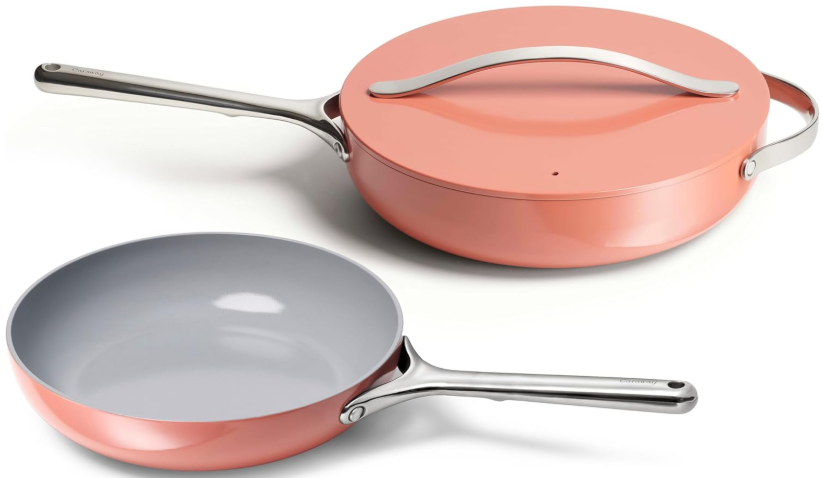
Product Description
Caraway has gained popularity for combining aesthetic design and non-toxic cooking. Their ceramic-coated cookware (often marketed as nonstick and free of PFAS, PFOA, lead, and cadmium) is meant to be functional and beautiful. Their sauté / fry pans tend to have smooth interiors and soft-handle designs, catering to everyday home cooks who want safe, stylish cookware.
Key Features
- Sol-gel ceramic nonstick surface (free of many “forever chemicals”)
- Aluminum core for heat conduction
- Oven-safe (often up to moderate temps, e.g. 400–450 °F)
- Multiple color options
- Magnetic base (for induction compatibility)
- Soft-touch or ergonomic handle
Pros
- Very attractive styling (colors and modern design)
- Decent nonstick performance, especially when new
- A known brand with a strong consumer following
- Lightweight and easy to maneuver
Cons
- May show signs of wear sooner under heavy use
- Less robust for high-heat cooking or professional-level use
- As with all ceramic coatings, must avoid abrasive treatment
- Lid or handle may restrict maximum temps
Recommendation
Choose the Caraway sauté pan if you value design + safe cooking in your kitchen. It is especially good for users who cook mostly at moderate heat and are careful in maintenance. For everyday sautéing of vegetables, fish, eggs, and lighter meats, it performs very well. If you push it too hard (with high heat, dry cooking, etc.), the coating will degrade faster.
4. Made In CeramiClad (Ceramic-Coated, Multi-Ply) Sauté / Fry Pan
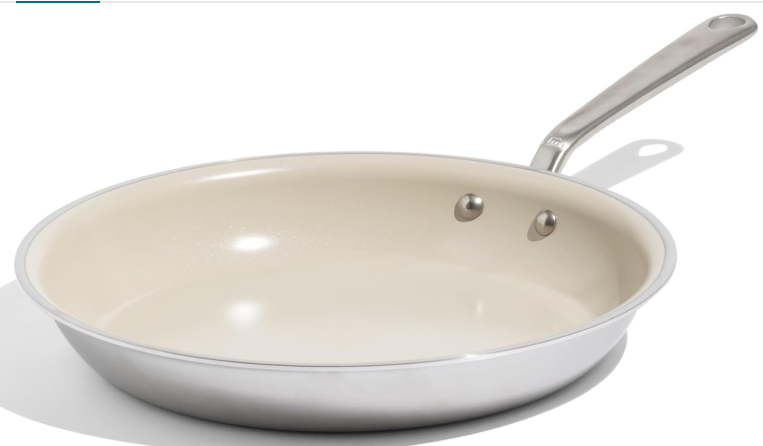
Product Description
Made In’s CeramiClad series departs from the typical thin ceramic-over-aluminum design by using a multi-ply (5-ply) construction. It sandwiches an aluminum core between stainless steel layers, and then applies a ceramic nonstick coating. This gives the pan more structural stability, less warp tendency, and better long-term performance under heavier use compared to many simple ceramic pans. (LeafScore)
Key Features
- 5-ply construction: stainless-steel outer layers + aluminum core (LeafScore)
- Ceramic nonstick (sol-gel)
- Induction-compatible
- Oven-safe to high temps (often 500 °F or more) (LeafScore)
- Stay-cool ergonomic handle
- Flared lip for easy pouring
- Partial exposed stainless rim to avoid edge chipping from lids rubbing (LeafScore)
Pros
- Much sturdier than typical ceramic pans
- Better longevity and resistance to warp or structural damage
- Excellent nonstick performance when new, even for delicate foods (LeafScore)
- Safer edge design helps reduce chipping risks
- Good oven performance
Cons
- More expensive than basic ceramic pans
- Heavier due to multi-ply construction
- Still subject to eventual wear of the ceramic coating
- Warranty may be limited (e.g. only 1 year) (LeafScore)
Recommendation
If you’re someone who wants “premium” within the ceramic-coated space, this is a top-tier option. It’s for users who demand both durability and nonstick performance and are willing to pay more. Especially good for those who will push the pan (higher heat, frequent use). If you want to stretch your ceramic sauté pan’s life, this is a great investment.
5. Tramontina Ceramic Nonstick Sauté / All-in-One Pan
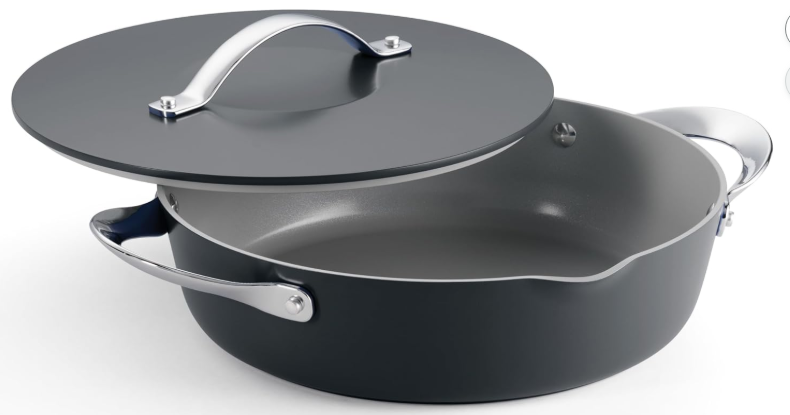
Product Description
Tramontina is a widely available, value-conscious cookware brand. Their ceramic nonstick models aim to offer safe, PFAS-free cooking at a lower price point. The “all-in-one” style (often pan + lid + steamer insert) is versatile, allowing searing, steaming, braising in the same vessel. In recent coverage, it has been praised for replacing multiple pans in a kitchen. (Food & Wine)
Key Features
- Ceramic nonstick interior
- Cold-forged aluminum body for even heating (Food & Wine)
- Versatile “all-in-one” design (pan + lid + steamer insert) (Food & Wine)
- Oven-safe (often up to ~400 °F) (Food & Wine)
- Compatible with various cooktops including induction (Food & Wine)
- Dishwasher-friendly (though hand wash recommended) (Food & Wine)
Pros
- Great versatility — can replace multiple pieces
- Strong value for price
- Decent nonstick performance for everyday cooking
- Good for individuals wanting fewer cookware items
Cons
- Not as premium or long-lasting as high-end ceramic pans
- Coating may degrade faster under heavy duty usage
- Lid or insert may limit heat tolerance
Recommendation
If you’re looking for a multipurpose pan that gives you sauté + steaming + braising options in one vessel, this is an excellent pick. It’s ideal for dorm kitchens, small apartments, or anyone who wants to minimize how many pans they own. It won’t match ultra-high-end durability, but for day-to-day use, it’s a solid performer.
6. Kyocera Ceramic Nonstick Fry / Sauté Pan (often 10″)
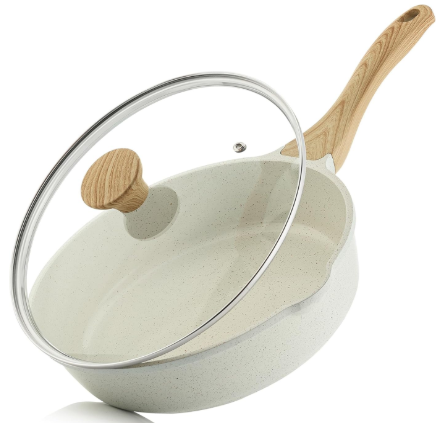
Product Description
Kyocera is known for early adoption of ceramic (or ceramic-like) nonstick coatings in their cookware. Their pans are often praised for strong nonstick performance and scratch resistance given their price point. In tests, they’ve held up well under stress. (Serious Eats) Their pans tend to be lightweight and manageable while still performing well.
Key Features
- Ceramic nonstick interior
- Lightweight aluminum body
- Induction compatibility (with magnetic base)
- Oven-safe to moderate temperatures
- Ergonomic handle design
Pros
- Very good nonstick release, especially for delicate items like eggs or fish (Serious Eats)
- Surprisingly scratch-resistant for its class (holds up in testing) (Serious Eats)
- Lightweight and easy to maneuver
- Good affordability relative to performance
Cons
- Less structural durability (thin body) compared to heavier pans
- Coating still degrades over time and with misuse
- Not ideal for very high heat or prolonged exposure
Recommendation
Choose the Kyocera pan if you want a reliable ceramic sauté pan at a mid-tier price. Ideal for frying eggs, fish, vegetables, light meats. If you’re not pushing heavy-duty cooking, this offers excellent value. Just be mindful to treat the coating gently (avoid high heat, use soft utensils, gentle cleaning).
Summary & Buying Notes
- Durability trade-off: The more premium and structurally reinforced pans (e.g. Made In CeramiClad, KitchenAid hard-anodized) tend to last longer and resist warping or damage, but cost more.
- Nonstick vs. lifetime: All ceramic coatings will eventually wear down; none last forever. Proper care (moderate heat, avoid abrasive cleaning, avoid metal utensils) is essential.
- Your usage matters: If you mostly cook light things (vegetables, eggs, fish), middle-tier models serve well. If grilling, searing, finishing in oven, go for more robust build and higher heat tolerance.
- Check lid/handle limits: Sometimes the lid or handle limits the safe oven temperature, even if the pan body is rated higher.
- Compatibility: For induction stovetops, ensure the model has a magnetic (steel) base or induction-ready design.
- Warranty & support: Premium brands often offer better warranty support; factor that in.
If you like, I can now pull the current Amazon listings with direct links, compare their prices, and even make a comparison table among them. Do you want me to do that next?
Here’s a small and clear comparison table for the 6 best ceramic sauté pans listed above 👇
| Product | Size / Material | Oven Safe | Induction Compatible | Key Strength | Ideal For | Price Range |
|---|---|---|---|---|---|---|
| GreenPan Valencia Pro | 11″ Hard-Anodized Aluminum + Ceramic | Up to ~425–450 °F | ✅ Yes | Premium PFAS-free ceramic coating | Everyday sautéing, healthy cooking | $$$ |
| KitchenAid Hard-Anodized Ceramic Pan | 5 qt / 11–12″ Hard-Anodized Aluminum | Up to ~500 °F | ⚙️ Some models | Durable, oven-safe build | Oven-to-table meals | $$$ |
| Caraway Ceramic Sauté Pan | 10.5″ Aluminum Core + Ceramic | Up to ~400–450 °F | ✅ Yes | Stylish, non-toxic coating | Modern kitchens, light meals | $$$$ |
| Made In CeramiClad Sauté Pan | 5-Ply Stainless + Ceramic | Up to ~500 °F | ✅ Yes | Professional-grade strength | Heavy-duty home or chef use | $$$$$ |
| Tramontina All-in-One Ceramic Pan | 11″ Aluminum + Ceramic | Up to ~400 °F | ✅ Yes | Multipurpose design (lid + steamer) | Small kitchens, minimal setups | $$ |
| Kyocera Ceramic Sauté Pan | 10″ Aluminum + Ceramic | Up to ~400 °F | ✅ Yes | Lightweight, great release | Light, everyday cooking | $$ |
Legend:
💲 = Budget 💲💲 = Moderate 💲💲💲 = Mid-Range 💲💲💲💲 = High-End 💲💲💲💲💲 = Premium
How to Use a Ceramic Sauté Pan
A ceramic sauté pan is easy to use, but to get the best results and longest lifespan, proper technique matters. Follow these simple steps for cooking like a pro while keeping your pan in perfect shape.
1. Preheat Gently
Ceramic coatings heat up quickly, so avoid blasting high heat right away.
- Start with low to medium heat.
- Let the pan warm up gradually for about 1–2 minutes before adding oil or food.
This helps prevent thermal shock and protects the nonstick surface.
2. Add the Right Amount of Oil
Although ceramic pans are nonstick, a light layer of oil or butter improves food release and flavor.
- Avoid nonstick spray—it can leave sticky residues that are hard to clean.
- Instead, use a few drops of olive, avocado, or canola oil for better cooking and even browning.
3. Cook with Gentle Utensils
To avoid scratching or chipping the ceramic coating:
- Use wooden, silicone, or nylon utensils.
- Never use metal spatulas, whisks, or forks on the surface.
Scratches can reduce nonstick performance and shorten the pan’s life.
4. Avoid Extreme Temperature Changes
Ceramic pans don’t like rapid changes in temperature.
- Never pour cold water into a hot pan.
- Let the pan cool down for a few minutes before washing.
This prevents warping and cracking of the coating.
5. Clean After Every Use
After cooking:
- Allow the pan to cool, then wash with warm water, mild dish soap, and a soft sponge.
- For stuck-on bits, soak the pan for a few minutes—don’t scrub aggressively.
- Avoid steel wool or harsh scouring pads.
Regular, gentle cleaning helps maintain the smooth ceramic surface.
6. Store Carefully
To protect the coating:
- Stack with pan protectors or soft cloths between pans.
- Avoid tossing them loosely into a cabinet where they can scratch each other.
Safety Guide for Using Ceramic Sauté Pans
Ceramic pans are generally safe and non-toxic, but a few smart habits will keep your cooking safer and your cookware lasting longer.
1. Keep Heat Moderate
Ceramic coatings can degrade under very high heat (above 500 °F or 260 °C).
- Use medium heat for most cooking.
- Reserve high heat for stainless steel or cast iron pans instead.
2. Check for Oven-Safe Limits
If your pan is oven-safe:
- Always verify the maximum temperature for both the pan and lid.
- Silicone or plastic handles may have lower limits (around 400 °F).
Never exceed the manufacturer’s rating.
3. Handle with Care
- Use oven mitts or potholders when handling hot pans.
- Ceramic and metal handles can retain heat longer than expected.
- Always place hot pans on heat-safe surfaces.
4. Avoid Using Damaged Pans
If the coating is cracked, chipped, or peeling, it’s time to replace the pan.
Cooking on a damaged surface can lead to uneven heating and food contamination.
5. Use the Right Cooktop
- Most ceramic sauté pans work well on gas, electric, or glass cooktops.
- For induction, make sure the pan has a magnetic base (check the label or try sticking a magnet to it).
Using a non-compatible pan on induction won’t heat properly.
6. Never Leave Unattended on Heat
Ceramic pans can retain heat longer than expected.
- Leaving them empty on high heat can cause discoloration or coating damage.
- Always add food or oil shortly after preheating.
7. Avoid Abrasive Cleaners
Stay away from baking soda scrubs, coarse salt, or powdered cleaners.
These can wear down the glossy surface over time. Stick to mild soap and soft sponges.
Pro Tips for Longevity
✅ Always cook on medium heat or lower.
✅ Wipe down the pan with a bit of oil after washing (seasoning-style) to maintain its slick finish.
✅ If you notice food sticking, give the pan a thorough deep clean with warm soapy water and re-oil lightly before next use.
✅ Store vertically if possible — less contact, less chance of scratching.
FAQs About the Best Ceramic Sauté Pan
1. Are ceramic sauté pans really nonstick?
Yes — ceramic coatings provide a naturally slick surface that prevents food from sticking without needing much oil. However, their nonstick performance depends on proper care. Avoid overheating, metal utensils, or abrasive scrubbing to maintain the coating’s smoothness and longevity.
2. Is ceramic cookware safe to use?
Absolutely. High-quality ceramic sauté pans are free from PFAS, PFOA, lead, and cadmium, making them one of the safest nonstick options available. Just make sure to buy from reputable brands and avoid using damaged or chipped pans.
3. Can I use a ceramic sauté pan on an induction cooktop?
Only if it’s labeled induction-compatible. Some ceramic pans include a magnetic stainless-steel base, which works perfectly on induction burners. Always check the product details or test with a magnet before buying.
4. How long does a ceramic sauté pan last?
With regular use and proper care, a high-quality ceramic sauté pan can last 2–5 years. Lower-cost models may wear out sooner if used frequently or cleaned harshly. The key is avoiding extreme heat and metal utensils.
5. Can I use metal utensils on ceramic pans?
No — metal utensils can scratch the nonstick coating. It’s best to use wooden, silicone, or nylon utensils. Scratches can reduce nonstick performance and cause the coating to deteriorate faster.
6. Why does food start sticking after a few months?
This usually happens due to overheating or buildup of cooking residue. Clean the pan thoroughly with warm water, mild dish soap, and a soft sponge, then wipe it lightly with cooking oil. This helps restore the surface and improves release.
7. Can I put my ceramic sauté pan in the dishwasher?
While some brands say their pans are dishwasher-safe, handwashing is always recommended. The dishwasher’s high heat and harsh detergents can dull or damage the ceramic surface over time.
8. How is a sauté pan different from a frying pan?
A sauté pan has straighter, taller sides and often comes with a lid, making it perfect for sauces, stir-fries, or shallow braising. A frying pan (skillet) has flared sides for faster evaporation and crispier sears. The sauté pan offers more versatility for one-pan meals.
Conclusion
Choosing the best ceramic sauté pan comes down to balancing performance, durability, and safety. Ceramic cookware offers a healthier, chemical-free alternative to traditional nonstick pans — ideal for anyone who values clean cooking and easy cleanup.
If you want premium performance and longevity, the Made In CeramiClad or GreenPan Valencia Pro stand out as top-tier options. For those who prefer style and safety, Caraway delivers both aesthetics and toxin-free cooking. Meanwhile, Tramontina and Kyocera provide excellent value for everyday users who want reliable, budget-friendly performance.
No matter which pan you choose, remember: ceramic cookware performs best with moderate heat, gentle utensils, and mindful cleaning. Treat it right, and your sauté pan will reward you with years of effortless, delicious cooking.